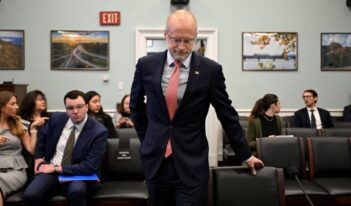
Scholars explain how the commercial space age creates demands for regulatory reform.
In 2004, Mike Melvill piloted an experimental aircraft to a peak altitude of over 100 kilometers. By some standards, his flight was rather unremarkable: the mission occurred more than 40 years after Yuri Gagarin’s first-ever human spaceflight and, in that span of time, over 400 people had ventured into space.
Yet the moment was historic, as Melvill’s flight was the first privately led mission to carry humans to space. His vessel, SpaceShipOne, was developed and deployed on two additional missions in 2004 with no government funding or coordination. As a result, some commentators have declared 2004 as the beginning of the age of space tourism.
Eager to kindle the emerging industry, Congress passed the Commercial Space Launch Amendments Act (CSLAA) in late 2004. The law granted the Department of Transportation, and, by extension, the Federal Aviation Administration (FAA), exclusive regulatory authority over the commercial space industry. The law also barred the FAA from enacting safety regulations for passengers on commercial space flights to give the industry an experimental “learning period.”
Recent space tourism missions by Blue Origin, SpaceX, and Virgin Galactic suggest that the era of commercial space activity is now in full swing, but some scholars claim that uncertainty still defines the state of space regulation. The scope of the Transportation Department’s regulatory authority—and the authority of the FAA, other agencies, and other non-state actors—on related issues remains unclear. With the CSLAA set to expire in October of this year, the FAA has begun exploring regulatory options, despite some scholars’ call for an extension of the FAA’s moratorium on passenger safety regulation.
The only recent international regulatory development—the Artemis Accords—establishes a framework for future agreements between participating countries, but according to some experts it does not address a gap left by past international space law about the obligations of non-state actors. Yet another concern arises from the fact that the Accords have been drafted under U.S. leadership without collaboration from the United Nations or participation from China or Russia.
Although one scholar has argued that the Accords represent an innovative form of adaptive international law, others have criticized them for “fracturing” space along political and legal lines. Still other scholars have noted that the Accords’ failure to establish a legal framework accepted by all countries involved in space exploration could lead to conflicts over other issues such as mineral rights, jurisdiction, and space debris.
In addition, although some scholars claim that a more comprehensive regulatory regime is essential, others argue that even the threadbare obligations that already exist are strangling U.S. enterprises in the commercial space sector.
In this week’s Saturday Seminar, scholars discuss the domestic and international regulatory framework surrounding commercial space activities, exploring the challenges that regulators face and seeking to chart the future for the law of space transportation.
- The existing legal framework for space flight is inadequate to regulate the activities of commercial actors in space, argues Matthew Pascale of the University of Illinois College of Law in the Illinois Journal of Law, Technology and Policy. Pascale contends that international treaties signed during the Cold War—the Moon Treaty of 1979 and the Outer Space Treaty of 1967—contain few provisions relevant to private actors that are increasingly involved in space flight, such as Blue Origin and SpaceX. To address these growing regulatory challenges, Pascale recommends updating existing U.N. treaty obligations with the adoption of a hybrid property rights regime that balances private interests with the idea of space as a “commons.”
- Department of Defense attorney and Air Force Reserve judge advocate John S. Goehring proposes a “rule of three” for the regulation of commercial space activities. According to Goehring’s article in the Journal of National Security Law & Policy, the United States can create an ideal regulatory environment by balancing three main policy objectives: promoting growth in the commercial space industry; satisfying international obligations; and preserving national security. To address future, unprecedented space activities while adhering to the rule of three, Goehring suggests employing a mission authorization framework, an interagency process for reviewing proposed activities, which was first proposed in a 2016 Office of Science and Technology Policy report. He explains that a mission authorization framework can impose the least burdensome conditions necessary to fulfill government interests and efficiently create “a clear and predictable regulatory environment.”
- In an article published in Southern Methodist University Dedman School of Law’s Journal of Air Law and Commerce, former Georgetown University Law Center professor Paul B. Larson contends that the United States, Russia, and China, as well as the European Space Agency, all fail to comport with international agreements in their pursuit of national space traffic regimes. In particular, Larson criticizes a space traffic management report issued under the Trump Administration which endorsed a “light touch” approach to regulation of commercial space activity. According to Larson, the report improperly prioritizes commerce over safety and fails to recognize the Outer Space Treaty or to consider conflicting regulations among nations. Larson argues that because outer space is inherently international, the United States should cooperate with other nations to establish international norms instead of merely pursuing its own objectives.
- In an article in the Minnesota Journal of International Law, Jamie McWilliam argues that, in the absence of U.N. leadership on the regulation of space resource extraction, the international community should turn to the World Trade Organization for guidance. McWilliam explains that although existing international law prohibits states from appropriating space resources, nations disagree as to whether this principle binds non-state actors. In addition, McWilliam argues that the U.N.’s failure to resolve this disagreement has led states to take action to establish property rights over space resources. McWilliam concludes by arguing that the most appropriate means of managing disputes would be for the international community to allow the World Trade Organization to articulate basic principles and set binding obligations on U.N. member states.
- In the American Business Law Journal, Michael B. Runnels of California State University, Los Angeles, argues that the Federal Communications Commission’s 2020 guidelines for commercial satellites fail to address the safety risks posed by “orbital debris,” the non-functional man-made objects that linger in Earth’s orbit. The Commission’s guidelines do not establish data-sharing requirements for commercial satellite operators, which Runnels contends are vital to minimizing safety threats posed by orbital debris. Runnels recommends amending federal law to require commercial satellite operators to disclose data essential to preventing satellite collisions and to prepare regular assessments of their impact on the low earth orbital environment. Clear congressional authorization to protect Earth’s orbital environment will, argues Runnels, help realize the widely proclaimed goal of using space for the “benefit and in the interests of all countries.”
- In a recent article for the New York University Journal of International Law and Politics, Eytan Tepper of Indiana University at Bloomington argues that the “polycentric governance” of space, according to which no regulating force dominates, is both an inevitable and a preferable outcome. Tepper explains that space law initially developed under a “global governance” paradigm, characterized by centralized decision-making led by the U.N. and embodied by a series of treaties signed in the 1960s and 1970s. But he argues that today no new treaties are likely to follow because of international political gridlock. Tepper explains, however, that even in the absence of strong centralized governance, a flexible network of “governance centers” will ultimately emerge, allowing stakeholders to direct the international governance of space by contributing to the development of protective norms.
The Saturday Seminar is a weekly feature that aims to put into written form the kind of content that would be conveyed in a live seminar involving regulatory experts. Each week, The Regulatory Review publishes a brief overview of a selected regulatory topic and then distills recent research and scholarly writing on that topic.



